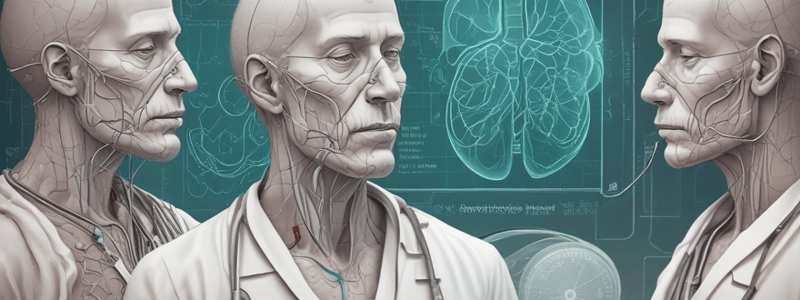Podcast
Questions and Answers
What is the primary requirement for oxygen therapy?
What is the primary requirement for oxygen therapy?
- Tracheostomy management
- Doctor's order (correct)
- Nursing intervention
- Client education
What is the oxygen flow rate range for a nasal canula?
What is the oxygen flow rate range for a nasal canula?
- 6-10L
- 0-55% O2
- 1-6L (correct)
- 0-6L
What is a complication of oxygen therapy?
What is a complication of oxygen therapy?
- Cystic fibrosis
- Asthma
- Oxygen toxicity (correct)
- COPD
What is the primary goal when administering oxygen therapy?
What is the primary goal when administering oxygen therapy?
What is the indication for tracheostomy management in oxygen therapy?
What is the indication for tracheostomy management in oxygen therapy?
What is a late sign of hypoxia?
What is a late sign of hypoxia?
What is the purpose of a Venturi mask in oxygen therapy?
What is the purpose of a Venturi mask in oxygen therapy?
What is an early sign of hypoxia?
What is an early sign of hypoxia?
What is the primary cause of chronic bronchitis?
What is the primary cause of chronic bronchitis?
What is the name of the breathing technique used to help patients with chronic bronchitis?
What is the name of the breathing technique used to help patients with chronic bronchitis?
What is the name of the test used to diagnose cystic fibrosis?
What is the name of the test used to diagnose cystic fibrosis?
What is the primary complication of cystic fibrosis?
What is the primary complication of cystic fibrosis?
What is the purpose of chest physiotherapy in the treatment of cystic fibrosis?
What is the purpose of chest physiotherapy in the treatment of cystic fibrosis?
What is the abnormal result of the ABG test in lung cancer?
What is the abnormal result of the ABG test in lung cancer?
What is the symptom of chronic bronchitis characterized by a bluish discoloration of the skin?
What is the symptom of chronic bronchitis characterized by a bluish discoloration of the skin?
What is the purpose of administering oxygen therapy in chronic bronchitis?
What is the purpose of administering oxygen therapy in chronic bronchitis?
What is the primary difference between hypoxemia and hypoxia?
What is the primary difference between hypoxemia and hypoxia?
What is the primary goal of incentive spirometry?
What is the primary goal of incentive spirometry?
What is a common symptom of influenza?
What is a common symptom of influenza?
What is the primary cause of pneumonia?
What is the primary cause of pneumonia?
What is the primary goal of chest physiotherapy?
What is the primary goal of chest physiotherapy?
What is a common symptom of tuberculosis?
What is a common symptom of tuberculosis?
What is the primary treatment for asthma?
What is the primary treatment for asthma?
What is the primary difference between COPD and asthma?
What is the primary difference between COPD and asthma?
What is the primary goal of nursing interventions for patients with pneumonia?
What is the primary goal of nursing interventions for patients with pneumonia?
What is the primary risk factor for obstructive sleep apnea?
What is the primary risk factor for obstructive sleep apnea?
Flashcards are hidden until you start studying
Study Notes
Respiratory Assessments
- Assessments include history of present illness, physical assessment, and laboratory tests
- Physical assessment includes:
- Clubbing of fingernails
- Mucous membranes
- Position of trachea (is it midline?)
- Breathing (are they using accessory muscles? Is their breathing even?)
- Vital signs
- Sputum
- ESR & CRP
- Chest x-ray
- CBC & CMP
Oxygen Therapy Management
- Oxygen therapy requires a doctor's order and is considered a medication
- Noninvasive oxygen delivery methods:
- Nasal Canula (1-6L, can titrate)
- Simple Mask (6-10L, can titrate)
- Venturi Mask (0-55% O2, "titrate" varies on the valve used)
- Non-Rebreather (100%, no titration)
- Continuous positive airway pressure (CPAP)
- Bi-level positive airway pressure (BIPAP)
- Tracheostomy (indicated if mechanical ventilation is required, max 2 weeks)
- Complications of oxygen therapy:
- Oxygen toxicity: symptoms include nonproductive cough, nasal congestion, substernal pain, headache, N/V, fatigue, sore throat, dry mucous membranes, infection
- Hypoxia: early signs include restlessness, irritability, use of accessory muscles, nasal flaring, tachycardia, tachypnea, hypertension; late signs include decrease in level of consciousness, increase in lactic acid, dysthymias, bradypnea, bradycardia, hypotension, cyanosis
- Hypoxemia: insufficient oxygen in the arterial blood
Infectious Respiratory Disorders
- Influenza:
- Highly contagious acute viral respiratory infection
- Symptoms: fever, chills, malaise, muscle aches, HA, rhinorrhea, cough, sore throat
- Diagnosis: rapid flu test
- Treatment: saltwater gargles, increase fluids, Tamiflu (first 48 hours), analgesics
- Nursing interventions: handwashing, vaccinations, avoiding close contact with infected people
- Pneumonia:
- Excess fluid in the lungs due to inflammation
- Symptoms: fever, SOB, chest pain, cough, dyspnea, crackles/wheezes
- Laboratory tests: increased WBC, decreased O2/increased CO2
- Diagnosis: chest x-ray (consolidation)
- Treatment: antibiotics, bronchodilators, oxygen therapy, Guaifenesin (Mucinex)
- Nursing interventions: high fowlers, oxygen therapy, cough and deep breath, incentive spirometer, increase fluid intake
- Tuberculosis:
- Upper airway disorders:
- Rhinitis/Rhinosinusitis:
- Nasal inflammation/sinus inflammation (allergies)
- Symptoms: nasal itching, runny nose
- Treatment: nasal spray, decongestants, antihistamine
- Nursing interventions: medication compliance, avoiding triggers
- Obstructive sleep apnea:
- Breathing disruption that occurs during sleep
- Causes: upper airway blockage
- Risk factors: overweight, birth defects, smoking
- Symptoms: persistent daytime sleepiness, irritability
- Treatment: C-pap, smoking cessation, weight loss
- Laryngitis:
- Inflammation of the larynx
- Laryngeal cancer:
- Cancerous growth on the vocal cords
- Symptoms: hoarseness, persistent sore throat, pain with swallowing, SOB
- Diagnosis: barium swallow, MRI, PET scan
- Treatment: chemotherapy, radiation, surgery, trach
- Laryngeal trauma:
Lower Airway Disorders
- Asthma:
- Chronic inflammation disorder of the airway
- Intermittent and reversible
- Triggered by allergen
- Symptoms: dyspnea, wheezing, chest tightness, coughing, tachypnea, prolonged expiration, increased sputum
- Diagnosis: pulmonary function test, ABG's
- Treatment: bronchodilators (can cause an increase in HR)
- Albuterol: short-acting bronchodilator for acute asthma attacks (reliever drug)
- Solumedrol (control therapy)
- Corticosteroids
- Nursing interventions: avoid triggers, pursed lip breathing, smoking cessation, track asthma with a peak flow meter (3 times and record the highest number)
- Status Asthmaticus:
- Life-threatening asthma attack
- Airway obstruction that is unresponsive to usual therapy
- Symptoms: extremely labored breathing, gasping, decreased level of consciousness, cyanosis, neck vein distention, pulsus paradoxes
- Treatment: bronchodilators, epinephrine, corticosteroids
- Nursing interventions: administer oxygen to the patient, prepare for emergency intubation and mechanical ventilation
Chronic Obstructive Pulmonary Disease (COPD)
- Combination of emphysema and chronic bronchitis
- Airway obstruction irreversible
- Emphysema:
- Destruction of the alveoli
- Decreases lung elasticity
- Hyperinflation and air trapping in the lungs
- Chronic bronchitis:
- Inflammation of the airways
- Hypersecretions of mucous
- Risk factors: smoking, air pollution, occupational
- Symptoms: cough, excess sputum, crackles/wheezes, barrel chest, red/blue skin, clubbing of nails, cyanosis, increased work of breathing, tripod position, SOB
- Laboratory tests:
- Decreased SpO2 (less than 90)
- ABG: 50/50 club
- PFT
- Chest x-ray
- Treatment: bronchodilators, corticosteroids, anticholinergics, oxygen therapy
- Nursing interventions: place patient in upright position, administer oxygen, monitor for R-sided HF, smoking cessation, pursed lip breathing, incentive spirometer, increase fluid and protein intake
Cystic Fibrosis
- Genetic disorder (autosomal recessive disorder)
- Severely impairs lung function and other organ functions
- Abnormally thick sticky mucous (plugs organ ducts)
- Can lead to organ failure
- Symptoms:
- Respiratory: wheezing, coughing, dyspnea, mucous plugs, cyanosis, clubbing, barrel chest, chronic respiratory infection
- Gastrointestinal: steatorrhea (fatty, malodorous stool), delayed growth, ADEK deficiencies
- Integumentary: abnormally high NaCl in sweat, saliva, tears
- Diagnosis: sweat Cl test, PFT, DNA testing, stool analysis
- Treatment: bronchodilators, anticholinergics, antibiotics, pancreatic enzymes
- Nursing interventions: chest physiotherapy, administer oxygen as ordered, increase fluid, protein, and calorie intake, supplement fat-soluble vitamins
Lung Cancer
- No specific notes provided in the text
Studying That Suits You
Use AI to generate personalized quizzes and flashcards to suit your learning preferences.





